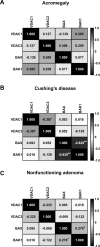The expression of VDACs and Bcl2 family genes in pituitary adenomas: clinical correlations and postsurgical outcomes
- PMID: 39449743
- PMCID: PMC11499145
- DOI: 10.3389/fendo.2024.1481050
The expression of VDACs and Bcl2 family genes in pituitary adenomas: clinical correlations and postsurgical outcomes
Abstract
Introduction: Pituitary adenomas (PAs) are benign tumors with high prevalence and, occasionally, aggressive course. The tumorigenesis of these lesions is not completely understood at the molecular level. BAK1 and BAX proteins play fundamental roles in apoptosis and seem to interact with VDAC proteins, whose expressions have been markedly altered in cancer, impacting their prognosis.
Objective: to evaluate the gene expression of VDAC1, VDAC2, BAK1 and BAX and their association with clinical and imaging characteristics in PA.
Methods: Clinical-epidemiological data were collected from 117 tumor samples from patients affected by PA. Invasiveness was assessed by the Knosp scale. Gene expression was examined by real-time PCR. Relative expression analysis was performed by 2^(-DDCt) method.
Results: The sample was mainly composed of women (69/117 - 57.2%). Tumor subtypes observed were Non-Functioning (NF) (73/117 - 62.4%), Acromegaly (24/117 - 20.5%) and Cushing's Disease (CD) (20/117 - 17.1%). Compared to normal tissue, there was a significant reduction in VDAC1 expression in the Acromegaly (p=0.029) and NF (p=0.002) groups. BAX expression was lower in all groups (p <0.001; p=0.007; P =0.005). No difference was found in VDAC2 and BAK1 expression, compared to normal pituitary. Overexpression of VDAC2 occurred in PAs with post-surgical regrowth (p=0.042). A strongly negative correlation was observed in BAX and BAK1 expression in CD.
Conclusion: The results indicated that downregulations of VDAC1 and BAX may be related to resistance to apoptosis. In contrast, overexpression of VDAC2 in regrowing PAs suggests an antiapoptotic role for this gene. In summary, the genes evaluated might be involved in the biopathology of PAs.
Keywords: BAK; VDAC; apoptosis; bax; pituitary adenoma; tumor regrowth.
Copyright © 2024 Facundo, Magalhães, Nascimento, Azulay, Santos, Freitas, Nascimento, Rodrigues, Santos, Beckman, Abreu, Silva, Carneiro, Oliveira Neto, Gil da Costa, Corcoy, Mato and Faria.
Conflict of interest statement
The authors declare that the research was conducted in the absence of any commercial or financial relationships that could be construed as a potential conflict of interest.
Figures


References
-
- Ng S, Messerer M, Engelhardt J, Cornelius JF, Cavallo LM, Cossu G, et al. . Aggressive pituitary neuroendocrine tumors: current practices, controversies, and perspectives, on behalf of the EANS skull base section. Acta Neurochir (Wien). (2021) 163:3131–42. doi: 10.1007/s00701-021-04953-6 - DOI - PubMed
MeSH terms
Substances
LinkOut - more resources
Full Text Sources
Medical
Research Materials

